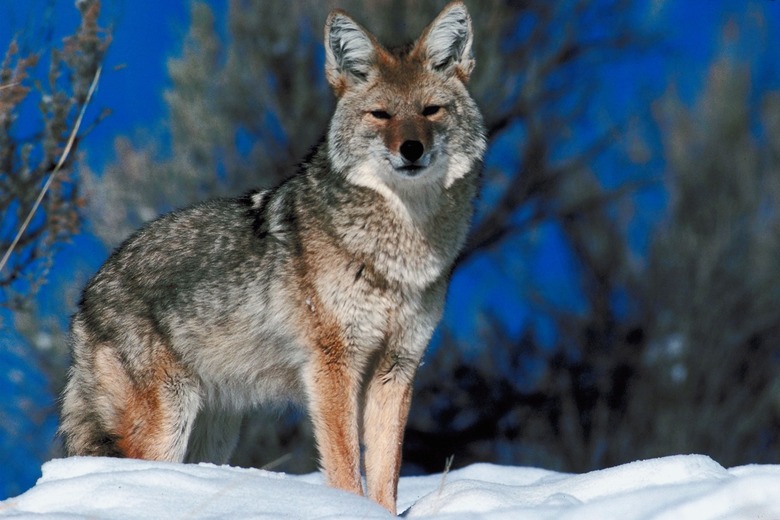What Are Some Similarites And Differences Between Wolves And Coyotes?
Wolves and coyotes are two types of canines that share many common traits. They are both members of the dog family, Canidae, and both types of canines belong to the genus Canis, which also includes jackals and domestic dogs. Wolves and coyotes are both doglike in appearance, have similar social organizations and are perceived to be threats to livestock. While these similarities exist, there are also major differences between wolves and coyotes.
Differences in Appearance
Differences in Appearance
One of the similarities between wolves and coyotes is that they seem very similar at first glance, but several differences are readily apparent. Coyotes have longer ears and a more pointed nose than wolves. Their legs are noticeably thinner and shorter than those of wolves. Coyotes' tails tend to be bushier, and they typically hold them down toward the ground, notes University of Minnesota Duluth. Wolves tend to carry their tails horizontally.
Coloring can vary greatly, but coyotes are generally a tan or brown color with reddish or yellowish patterns. Wolves have a broader snout, larger paws and longer, thicker legs. Their coloring can range from gray to white to black.
Differences in Size
Differences in Size
One major difference between wolves and coyotes is their size. Wolves are much larger and heavier than coyotes – they are about twice as big, according to University of Minnesota Duluth. Male wolves can reach lengths of seven feet (including 20 inches of tail). Wolves may also weigh upwards of 175 pounds, although weights between 100 and 125 pounds are more typical.
By contrast, coyotes rarely reach five feet in length and usually weigh between 25 and 75 pounds. Eastern coyotes are generally slightly larger than their western counterparts.
Wolf and Coyote Packs
Wolf and Coyote Packs
Wolves are highly social creatures that live and hunt in packs. These packs are organized in a strictly hierarchical structure. Packs vary in size, but six to ten members are typical. Only the alpha male and his mate breed, although all pack members help care for the pups.
Coyotes are also social, and packs are more prevalent than mated pairs. Complex packs are more likely to occur in the northern and western parts of their range. In contrast to wolves, coyotes have developed a more solitary means of hunting. This may be due to the fact that coyotes prey on smaller animals than wolves.
Where They Live
Where They Live
Coyotes have shown an amazing ability to adapt to a wide variety of environments, including urban areas. While originally limited to the western United States, their range now covers all of North America including Alaska and most of Canada. It also stretches through Mexico and into Central America as far south as Panama.
Wolves once ranged throughout most of North America, but are now found only in Canada, the northern United States and Yellowstone National Park.
Competition for Food and Habitat
Competition for Food and Habitat
Wolves and coyotes, as large predators, often compete for the same habitats and food sources. The coyotes' range has increased in part due to the decrease in the population of wolves. However, where wolf populations still exist, the presence of coyotes is reduced. When wolves were reintroduced into Yellowstone National Park in 1995, the park saw a corresponding decrease in the population of coyotes.
Because both species are losing habitat due to climate change, scientists have discovered that wolves and coyotes are beginning to interbreed, according to The World. Hybridization between wolves, coyotes and domestic dogs may be a way for the species to adapt and survive in changing environmental conditions.
Wolf and Coyote Howls
Wolf and Coyote Howls
Both wolves and coyotes are known for their howling. Wolves appear to howl to communicate with other wolves. These communications may involve location or confrontation over territory.
Coyotes also communicate vocally. They may howl either to coordinate hunting or to locate pack members. A group of coyotes howling together may warn other packs of territorial boundaries.
Cite This Article
MLA
J.D., Randall Pierce. "What Are Some Similarites And Differences Between Wolves And Coyotes?" sciencing.com, https://www.sciencing.com/similarites-differences-between-wolves-coyotes-10042368/. 30 September 2021.
APA
J.D., Randall Pierce. (2021, September 30). What Are Some Similarites And Differences Between Wolves And Coyotes?. sciencing.com. Retrieved from https://www.sciencing.com/similarites-differences-between-wolves-coyotes-10042368/
Chicago
J.D., Randall Pierce. What Are Some Similarites And Differences Between Wolves And Coyotes? last modified March 24, 2022. https://www.sciencing.com/similarites-differences-between-wolves-coyotes-10042368/
